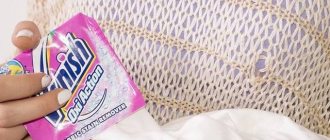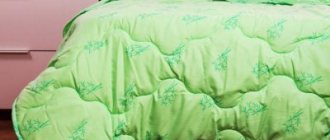Every wardrobe should have at least one white shirt, as it is versatile and fits into any style.
But it is not so easy to keep it unchanged. To do this, you need to know the basic rules for washing white clothes.
We’ll tell you in this article how to properly wash white shirts in the washing machine and by hand, and how to get rid of stains so that they become snow-white again.
How to wash a shirt by hand
Washing white shirts by hand is a snap. But first you need to remove dirt from the fabric and only then start washing. The most effective means for getting rid of stains of various origins are:
- chemical stain removers;
- laundry soap;
- ammonia and glycerin, combined in equal proportions;
- baking soda with lemon juice added.
The product is applied to a damp cloth at the site of contamination and then washed off with warm water. After removing the stains, you can proceed to the next step, namely washing. You need:
- Prepare a bowl of water (the recommended temperature is indicated on the shirt label).
- Add powder or liquid laundry detergent.
- Leave the item in the soap solution for 30 minutes.
- Lightly rub dirty areas.
- Rinse the item.
After washing, clothes are usually rinsed in cold water and then sent to dry. It is better to wash the shirt by hand. This method is safer for the fabric than using a washing machine.
Cosmetics stains
If foundation, concealer or lipstick gets on your shirt, you will need other products. The fact is that cosmetics contain large amounts of fat. Not all bleaches can remove such stains. It is better to give preference to the following options:
- a mixture of lemon juice and baking soda;
- dish gel;
- toothpaste;
- pure or diluted ammonia;
- special chemical stain remover.
Any mixture mentioned should be applied to the stain and left for a few minutes, lightly rubbing with a sponge or hand. Afterwards, we rinse and wash the laundry in a machine or by hand.
Can shirts be washed in a washing machine?
Many people are interested in the question of whether it is possible to wash white clothes, including shirts, in a washing machine. It is possible if the product label does not indicate that this is contraindicated for a particular type of fabric.
To avoid causing damage to the product, you must follow certain rules, namely:
- put white things in the drum separately from colored ones;
- distribute products according to fabric type and recommended washing mode, which is indicated on the label;
- select the powder in accordance with the characteristics of the material.
In addition to the above, the success of washing depends on the correct choice of temperature.
At what temperature should you wash shirts in a washing machine?
The correctly selected mode when washing a shirt in a washing machine is necessary to obtain the desired result. The recommended temperature is indicated on the product label, and if it is not preserved or washing information is missing, please note the following:
- shirts made of linen and cotton can withstand temperatures up to 95 degrees;
- synthetic fabrics are washed at 50 degrees;
- for delicate materials the temperature should not exceed 40 degrees.
In addition to choosing the temperature setting, you also need to know how to properly wash shirts in a machine so as not to deform the product.
Folk recipes for cleaning compositions
Folk laundry detergents can be a good alternative to household chemicals. They are based on available ingredients and simple technology for preparing cleaning compositions.
Mustard
The use of natural mustard allows for careful, delicate washing of items, including those made of natural silk and wool.
For manual processing you will need:
- 3 l. water;
- 3 tbsp. mustard powder.
Processing order:
- Pour water into the container.
- Dissolve the mustard.
- Leave for 120 minutes.
- Strain the solution.
- Pour it into a bowl of hot water.
- The remaining mustard should be poured again into 3 liters. water.
- Things are washed in a water infusion of mustard.
- During the last rinse, you can add 1 tbsp to the water. l. vinegar per 1 liter. liquids. For wool – 1 tsp. ammonia per 1 liter. liquids.
Soda ash - for flax and cotton
This product has good effectiveness when processing linen and cotton items.
Cons of soda:
- inability to use wool and silk for washing;
- impossibility of use for processing fading fabrics.
For washing with soda ash to be effective, the water temperature must be at least +50ºС. The substance diluted in water allows you to effectively deal with contaminants.
For greater effect, use a short pre-soak for 10-15 minutes.
Homemade gel
For 1 l. water:
- grate 50 grams of laundry soap;
- soda ash – 50 grams or regular table soda – 200 grams;
- essential oil (for aromatization) – 7 drops.
Cooking process:
- Bring water to a boil.
- Add soap shavings.
- Add soda.
- Stir until the soap is completely dissolved.
- Remove from heat. As it cools, the mixture will thicken, acquiring a gel concentration.
- After the mixture has cooled, add essential oil and mix again.
The gel is used at the rate of 2 tbsp. l. for one basin of water with washing. Store the washing gel in a tightly closed container. Before use, it is advisable to stir the composition so that it becomes homogeneous.
Salt solution for calico
The salt-based recipe is suitable for washing items made from natural fabrics based on plant materials - linen and chintz.
Procedure:
- Immerse the products in clean water for a quarter of an hour.
- Drain the water, put things aside.
- Dial 5 l. water.
- Add 5 tbsp. l. kitchen salt.
- Stir until the salt is completely dissolved.
- Dip things in water.
- Leave for 60 minutes.
- Rinse as usual after washing.
The method is only suitable for natural fabrics made from plant materials.
Beans for sweaters
What you need as a detergent is not the beans themselves, but the infusion. Preparation procedure:
- in 1 l. soak 0.2 kg of beans in water;
- cook until the beans are ready;
- strain the liquid through cheesecloth;
- add the decoction to a bowl of water intended for washing;
- beat the washing solution by hand;
- wash as usual;
- rinse.
Bean decoction makes woolen items soft and fluffy.
Soap nuts
This is a natural product that comes from Asia. You can buy it in eco-goods stores. All you need for washing is a nut shell.
Procedure:
- Place 10 shells in a washing bag.
- The bag is placed in the basin.
- Pour hot water.
- Leave for a quarter of an hour, periodically kneading the contents of the bag.
- Dipping things into a basin.
- Leave things for 15-20 minutes.
- Start washing by hand.
- After washing, items should be rinsed.
Used soapy nut shells are dried and set aside until the next wash. One bag is enough for 5 washing sessions.
This product is suitable for treating children's clothing, underwear for allergy sufferers and for those with dermatological diseases.
How to properly wash shirts in a washing machine
Machine washing is not as safe for clothes as hand washing and contributes to rapid wear of the material. To reduce the negative impact, the following rules must be observed:
- Choose the right detergents.
- Before washing a white shirt, fasten all the buttons on the item. This will not only preserve the item, but also not damage the drum of the machine.
- Select the “hand wash” mode for shirts.
- Avoid spinning clothes.
Even after proper washing, the collar and cuffs do not always look perfect. To keep problem areas looking good, you need to use little tricks.
Rules of care
In order for your favorite shirt to last longer and maintain a presentable appearance, it is not enough to follow the basic rules of successful washing; you also need to take into account methods for proper drying without deforming the fabric and ironing at optimal modes and temperatures.
Drying
The main criterion when choosing the optimal drying method is the type of fabric from which the product is made, but there are also general recommendations that must be followed to properly care for any shirt.
- Under no circumstances should the product be dried by throwing it over a clothesline. This point must be taken into account so that there are no creases or excessive wrinkles on the shirt. When drying in this way, the material is significantly deformed, and the consequences cannot always be eliminated even with the help of a powerful iron.
- It is recommended to dry shirts on hangers, avoiding contact with other things. Even after washing, while the items are still damp, the proximity of white and colored clothing can lead to staining.
- During drying, you should carefully straighten the fabric and unbutton the cuffs, this way fewer wrinkles will form, which will significantly reduce ironing time in the future.
IMPORTANT:
If the item shrinks a little after washing, then before drying it is necessary to slightly stretch the shirt; this procedure should be carried out as carefully as possible and only with the item still damp.
Ironing and steaming
The process of ironing washed shirts is not easy and is far from the most favorite among most housewives. Steaming is considered the easiest way to get rid of wrinkles, but quick and high-quality results using this method can only be achieved for items made of thin and delicate fabrics. This method is the safest for these materials. It is possible to steam a cotton shirt with high quality, but the process will take more time and effort than a similar procedure using an iron.
To achieve the best result, there are also several general rules, following which you can reduce time costs and at the same time get a high-quality ironed item.
- You should not wait for the shirt to dry completely; it is much easier to iron a slightly damp item, but you must strictly observe the temperature regime so as not to spoil the product.
- The sequence of this procedure also plays a very important role and it is the same for products made from all types of fabric. First, iron the cuffs and sleeves, followed by the back and front side. Lastly, the area near the buttons and collar are ironed. Adhering to this scheme will help minimize the appearance of new folds.
- The ironed item must be hung on hangers and the top button fastened so that the collar does not lose its shape. It is not recommended to put on a shirt immediately after ironing; while the material is still warm, it wrinkles much faster.
Using these tips, you can not only extend the life of your items, but also maintain the original quality of your favorite shirt.
How to wash a shirt collar and cuffs
How to wash the collar of a white shirt and return the original whiteness to the cuffs, which get dirty the most? Before washing the item, problem areas are subjected to special treatment. You can choose one of these methods:
- apply a solution of salt, water and ammonia, combined in equal proportions, to the collar and cuffs for 15–20 minutes;
- treat contamination with hydrogen peroxide and a concentrated solution of laundry soap;
- moisten problem areas of the fabric with vinegar for 10–15 minutes.
To keep your white clothes in perfect condition, it is not enough to know what and how to wash your shirt collar and cuffs. Often stains appear on clothes in the form of yellow spots in the armpits - these are traces of sweat and deodorant.
Wine stains
It is not difficult to remove red wine from white fabric if you immediately react to the stain. It is strongly not recommended to delay cleansing, as completely absorbed and dried “redness” will damage the item irrevocably. Therefore, we do not hesitate and act immediately.
- Lay the shirt out on the table, not allowing the stain to transfer to the clean fabric.
- Fill the wine mark with warm wine or vodka.
- Add salt, pour boiling water on top and leave for 1-2 hours.
- Dry with a dry cloth.
- Cover the trail with powdered citric acid and pour citrus juice on top.
- We wash by hand or in a machine.
If the shirt material is too thick, then it is better to go the other way and treat the contaminated area with liquid Domestos. Lubricate the wine stain, leave for 5 minutes and rinse. Be sure to load it into the washing machine and run a full cycle.
It is easier to remove white wine residue from a shirt. Crushed ice on the laundry and washing in a solution of soap and soda will help get rid of wine stains. A shirt is also effectively cleaned when, after washing, the mark is rubbed with laundry soap or washed with a water-alcohol mixture. In severe cases, mix ammonia, turpentine oil and soap, and then lubricate problem areas with the mixture.
How to remove yellow stains from a white shirt
It is difficult to remove yellow stains without using special products, and ordinary washing powder is not enough. There are several ways to restore the original whiteness of a product:
- Use a non-chlorine stain remover or bleach according to the instructions on the package. However, this method only removes fresh stains.
- Boil clothes with bleaching agents. This method is only suitable for natural and fairly dense fabrics. Lavsan, wool and silk are strictly prohibited from being subjected to such treatment.
- Use liquid soap, baking soda and salt. The components are taken in equal proportions and combined until a homogeneous mass is formed. The mixture should be quite thick. Then it is applied to the yellowed areas and left for 30 minutes.
After the stains have been removed, the product must be washed as usual and dried in fresh air.
Traditional recipes for use at home
Using simple folk recipes, you can thoroughly clean shirt collars. To do this, you will need tools that can easily be found in the kitchen or in your home medicine cabinet.
When choosing, you must take into account the color of the product, since some acid-based products can discolor the collar material.
Vinegar
Table vinegar can act as an affordable, inexpensive stain remover.
For processing you will need:
- vinegar;
- brush;
- sponge;
- water.
Procedure:
- Moisten a sponge with vinegar.
- Gently work the collar using rubbing movements.
- Use a brush to wash off the vinegar along with the dirt.
- Wash the entire shirt.
Acetic acid has the property of discoloring bright shades, so its use for colored items is undesirable.
Salt and ammonia
For old stains that have been absorbed into the fabric, a recipe based on ammonia and salt is suitable. For cleaning you will need:
- bowl for mixing components;
- ammonia;
- salt;
- sponge;
- water.
Treatment of the contaminated area includes the following steps:
- Combine 1 tsp in a prepared container. salt and 4 tsp. ammonia.
- Pour 4 tbsp into the mixture. l. water.
- Stir.
- Apply the resulting product with a sponge to the collar fabric.
- Wait a quarter of an hour.
- Wash the shirt.
Aspirin
One of the non-trivial methods of washing the collar of a white shirt is using aspirin tablets. For processing you need to prepare in advance:
- aspirin (2 tablets);
- sponge;
- water;
- a small container in which the solution will be prepared.
Procedure:
- Measure ½ cup of warm water into a container.
- Dilute aspirin in water.
- Stir well.
- Soak the sponge in the solution and treat the surface of the collar. Movements should be directed from the edge of the spot to the middle.
The aspirin recipe is best used only for white shirts, since the acetylsalicylic acid contained in the tablets can discolor colored fabrics.
Baby powder or talcum powder for yellow streak
Regular talc can help clean your collar from traces of wear and yellow stains. This recipe is suitable if you have a day to wash your shirt.
Instructions:
- Sprinkle a thick layer of talcum powder on the collar.
- Set the shirt aside for 10-12 hours.
- Clean off any remaining product.
- Wash.
This method will also help deal with sweat stains and traces left by deodorant under the arms.
Hydrogen peroxide and soap
A recipe with peroxide will help you clean your shirt collar; it gives fairly quick results. To implement it, you need to prepare in advance.
You will need:
- laundry soap;
- grater;
- sponge;
- water;
- Bowl;
- sponge;
- container for preparing soap solution;
- hydrogen peroxide.
Work order:
- Grate soap (1/4 piece).
- Pour into a bowl.
- Dissolve soap shavings in water (1 liter).
- Using a sponge, apply soap to the collar, cuffs and other soiled areas.
- Using a cotton sponge, apply ammonia to the stained areas on top.
- Leave for 30-40 minutes.
- Wash the shirt without washing off the composition applied to the collar.
Turpentine
The use of turpentine is justified in cases where the collar has not only signs of wear, but also stains from cosmetics. For example, from foundation or lipstick. It is convenient to apply turpentine to the collar with a sponge.
Cleaning procedure:
- Apply turpentine to the sponge.
- Rub the stain so that the cleaning agent saturates the stained area. At the same time, dirt should not be allowed to drive deep into the fibers of the material.
- Blot the treated area with a napkin or disposable towel.
- Evaluate the effect of the manipulation.
- If the stains are removed, the product can be washed.
If the stains are not gone, you need to move on to the next step:
- Soak the fabric even more with turpentine, treating the collar on both sides.
- Attach landscape sheets of paper to the collar on both sides.
- Iron the collar through the paper.
- The treatment ends by washing the shirt with detergent.
Dish detergents
Using dishwashing detergent is one easy way to remove stains from a shirt collar. For washing you will need:
- brush;
- dishwashing detergent;
- water.
Work order:
- Wet the shirt collar.
- Spread 1-2 drops of dishwashing detergent over the stained side.
- Rub the stain with a brush.
- Set aside for 30 minutes.
- Rub again with a brush.
- Rinse in water.
- Wash the shirt as usual.
How to wash a linen shirt
Linen is a popular type of fabric; items made from this material, if properly cared for, can last for many years.
Hand washing is more preferable for linen items than machine washing. When tidying up such a thing, you must follow the following rules:
- use cleaning products without chlorine;
- wash linen at a temperature not exceeding 40 degrees;
- use plenty of water when rinsing.
If you hand wash several items at once, choose a large container; the items should not “embarrass” each other. When using the machine, you should also not “compact” a bunch of clothes into the drum. After finishing washing, linen clothes should be dried in fresh air. It is better if the material is not exposed to direct sunlight, otherwise the product will dry out and it will be difficult to iron it.
Recommendations
Expert advice on washing T-shirts will help you keep your item in order and preserve its appearance.
Important recommendations include the following:
- If the T-shirt has decorative or functional fasteners (buttons, zippers), they must be fastened before washing.
- Stains that are on a worn item must be removed before the main wash, and not after it.
- It is recommended to wash colored items no more than 3 times after dressing, and white items no more than 2 times.
- If items have rhinestones, complex appliqués, etc., they should not be caught with the tip of the iron during ironing.
- Adding a couple of tablespoons of vinegar to the rinse water will help maintain the brightness of the shades.
- Hand washing should preferably be done with rubber gloves.
How to dry a shirt after washing
To avoid deformation of the product after washing, it is necessary to dry the shirt properly. This is done in compliance with the following rules:
- The washed item is dried by hanging it on hangers;
- before sending clothes into the fresh air, fasten all the buttons;
- the collar of the product must be straightened, otherwise it will be deformed and will not “lie” as it should;
- cuffs are fastened and aligned;
- All folds and creases in the fabric are straightened out.
If you follow these tips, you can independently and without much effort return the original whiteness and decent appearance of your favorite shirt.











